Digital Posters
MRA Outside the Head: It's a No-Brainer!
ISMRM & SMRT Annual Meeting • 15-20 May 2021

| Concurrent 3 | 19:00 - 20:00 |
1611. |
Feasibility of Free-Breathing Non-contrast Magnetic Resonance Pulmonary Angiography
Jia Liu1, Kai Zhao1, Wei Li1, Zhongxu Bi1, Jinxia Zhu2, Xiaoye Wang3, and Jianxing Qiu1
1Peking University First Hospital, Beijing, China, 2MR Collaboration, Siemens Healthcare Ltd, Beijing, China, 3MR APP, Siemens Healthcare Ltd, Beijing, China
We investigated the feasibility and clinical value of free-breathing non-contrast MR pulmonary angiography (MRPA). The subjective diagnostic image quality values, evaluated by two radiologists, showed excellent consistency. Non-contrast MRPA can provide acceptable image quality that can be applied broadly in clinical medicine.
|
|||
1612.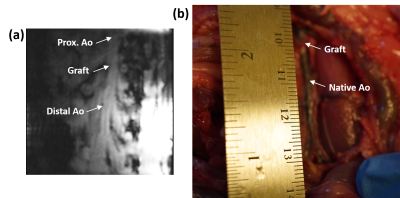 |
MRI for evaluating compliance of aortic graft in a rat model and comparison to native aorta
El-Sayed H Ibrahim1, Xiaolong Wang1, and Bo Wang1
1Medical College of Wisconsin, Milwaukee, WI, United States
Vascular tissue-engineering provides an alternative solution to replace autologous vessels via developing an artificial vascular graft. To examine the in-vivo fate and understand the clinical potential of the artificial vascular graft, the graft was implanted into the abdominal aorta of Sprague-Dawley rats by end-to-end anastomosis. The goal of this study was to evaluate compliance and vessel wall stiffness in the artic graft and compare results to native aorta using MRI. The results demonstrated that the developed graft has biomechanical characteristics similar to those in native aorta, which may represent a potential avenue to construct a flexible vascular graft in patients.
|
|||
1613.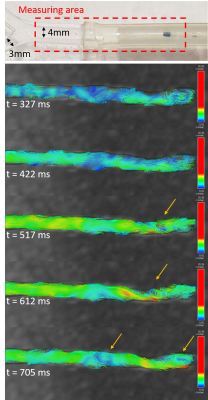 |
Turbulences in a one bifurcation 4mm diameter phantom after inflating a balloon catheter: a 4D flow/cine phase invitro study at systemic pressure.
Cyril Tous, PhD1, Ivan Dimov1, Ning Li, PhD1, Simon Lessard, PhD1, An Tang, MD, MSc1,2, Samuel Kadoury, PhD1,3, and Gilles Soulez, MD,MSc1,2
1Radiology, Centre de recherche du Centre hospitalier de l’Université de Montréal, Montreal, QC, Canada, 2Radiology, Université de Montréal, Montréal, QC, Canada, 3Polytechnique Montréal, Montréal, QC, Canada
Turbulent flow undermines steering of magnetic microrobots across bifurcations using the MRI gradients. A partial inflated balloon can reproduce a blood flow controlling method in vivo, to increase the targeted success rate of embolization by microrobots. At 3T MRI, 4D flow reveals that vortices in front of the catheter were generated. These series of vortices are also confirmed through by ink injection and under videos capture. At 4 mm diameter, 4D flow and cine phase are reproducible for average velocity and net flow at 0.8mm2 in plane resolution. These in vitro results can be used to refine 4D flow models.
|
|||
1614.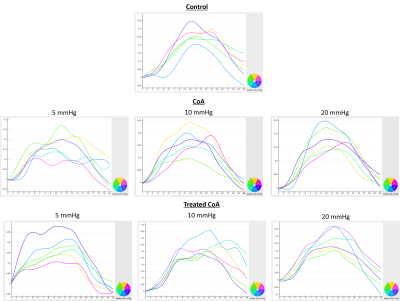 |
Differentiating cardiac function and hemodynamics in treated and untreated models of aortic coarctation
El-Sayed H Ibrahim1, Jamasp Azarnoosh2, Arash Hassankiadeh1, Pierre Croisille3, Jadranka Stojanovska4, and John LaDisa2
1Medical College of Wisconsin, Milwaukee, WI, United States, 2Marquette University, Milwaukee, WI, United States, 3Jean-Monnet University, Lyon, France, 4University of Michigan, Ann Arbor, MI, United States
Aortic coarctation (CoA) is a congenital vascular disease characterized by severe narrowing of the proximal descending thoracic aorta, which affects 5,000-8,000 births annually in USA. Patients with CoA can have altered hemodynamics and remodeled left ventricle from increased afterload. In this study, we investigate the impact of CoA on cardiovascular parameters using rabbit models of treated and untreated CoA. The results showed that cardiovascular parameters can normalize in treated CoA compared to untreated cases and that myocardial strain and aortic blood velocity are sensitive parameters for differentiating between treated and untreated CoA as well as the severity of coarctation.
|
|||
1615.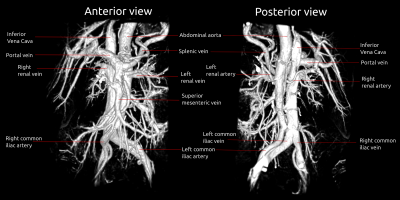 |
Optimization of Ultrashort TE protocol QUTE-CE with ferumoxytol for abdominal MRA
Tianyi Zhou1, Liam Timms1, Valur Olafsson2, Fred Bidmead2, Vishala Mishra3, Ravi T Seethamraju4, Mukesh Harisinghani3, and Srinivas Sridhar1
1Department of Physics, Northeastern University, Boston, MA, United States, 2Northeastern University Biomedical Imaging Center, Boston, MA, United States, 3Department of Radiology, Massachusetts General Hospital, Boston, MA, United States, 4Siemens Medical Solutions, Boston, MA, United States
A contrast-enhanced MRA protocol with Ultrashort Time-to-Echo (UTE) was optimized on phantoms covering a range of ferumoxytol concentrations for abdominal imaging. This approach produces images with high SNR (~ 4166) at clinical concentrations. The protocol was applied in vivo to human subjects for abdominal vascular imaging. Acquired human images demonstrated great delineation of central and peripheral vessels in the liver, kidneys and other abdominal organs. The combination of an optimized UTE sequence and the blood-pool kinetics of ferumoxytol enables high-resolution vascular imaging across the entire abdomen with maximized image quality. This technique could potentially aid in characterization of vascular diseases.
|
|||
1616.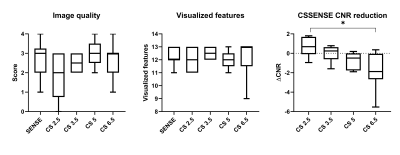 |
Accelerated 3D whole-heart angiography using Compressed SENSE in patients with Congenital Heart Disease
Mubeena Abdulkarim1, Munes Fares1, Mohammed Hussain1,2, Gerald Greil1, Tarique Hussain1, and Joshua Greer1
1Pediatric Cardiology, University of Texas Southwestern, Dallas, TX, United States, 2Kafrelsheikh univeristy, Kafr El Sheikh, Egypt
3D whole-heart bSSFP (3DWH) is the clinical standard in the evaluation of anatomy in congenital heart disease (CHD), but can be time consuming to acquire. A compressed sense (CS-SENSE) algorithm to accelerate standard SENSE technique recently became commercially available, and was shown to accelerate clinical protocols in adults. 3DWH accelerated by CS-SENSE factor of 3.5 provided visualization of all structures with no degradation in CNR or image quality while reducing scan time by approximately 25% in pediatric congenital heart disease.
|
|||
1617.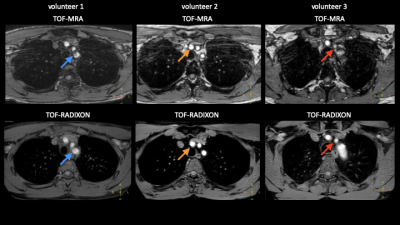 |
3D time of flight MRA using radial-based gradient echo pulse sequence with modified DIXON of the aortic arch bifurcation
Takashi Namiki1, Masami Yoneyama1, Hiroshi Hamano1, Tomohiro Mochizuki1, Yuki Ito1, Mai Nishihara1, and Yasutomo Katsumata2
1Philips Japan, Tokyo, Japan, 2Philips Healthcare, Best, Netherlands
Inflow magnetic resonance angiography (MRA) plays an important role in catheter insertion for intracranial endovascular treatment in the visualization of blood vessels at the aortic arch bifurcation. However, it is often difficult to accurately determine vascular stenosis due to respiratory artifacts and surrounding fat. In this study, we employ 3-dimensional time of flight MRA using radial-based gradient echo pulse sequence with modified DIXON (TOF-RADIXON) compared it with 3-dimensional time of flight MRA (TOF-MRA). The experimental results using TOF-RADIXON showed that ability to visualize blood vessels is more promising than TOF-MRA.
|
|||
1618.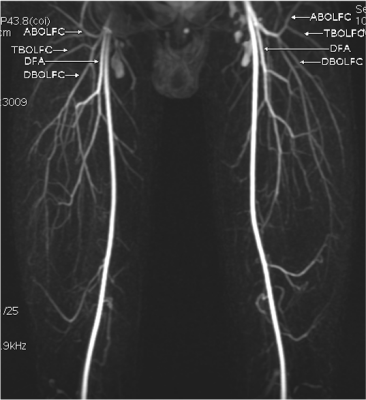 |
Contrast enhancement DISCO magnetic resonance angiography in preoperative assessment of anterolateral thigh flap
yunfeng shen1 and Weiqiang Dou2
1shandong university, Jinan, China, 2GE Healthcare, Beijing, China
Anterolateral thigh (ALT) flap has been widely used in reconstructive surgery for head and neck region and the extremities. However, the difficulties during the dissection of this flap were often associated with various vascular anatomies and frequent intramuscular course of perforators [1]. In this study, using a novel differential subsampling with cartesian ordering (DISCO) contrast enhancement magnetic resonance angiography, the patterns of lateral circumflex femoral artery and its branches were clearly identified, and were consistent with operative findings. Therefore, DISCO imaging can be an accurate and compatible method for perforators imaging preoperatively prior to ALT flaps.
|
|||
1619.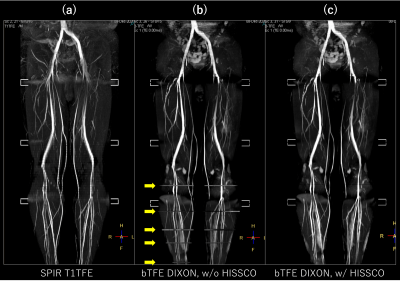 |
Non-contrast-enhanced MR venography of lower extremity using balanced-TFE mDIXON with robust water-fat swap correction
Jihun Kwon1, Masami Yoneyama1, Yasuhiro Goto2, Yutaka Hamatani2, Isao Shiina2, Kazuo Kodaira2, Takumi Ogawa2, Michinobu Nagao3, Kayoko Abe3, Takashi Namiki1, and Marc Van Cauteren4
1Philips Japan, Tokyo, Japan, 2Department of Radiological Services, Tokyo Women’s Medical University, Tokyo, Japan, 3Department of Diagnostic Imaging and Nuclear Medicine, Tokyo Women’s Medical University, Tokyo, Japan, 4Philips Healthcare, Best, Netherlands
Magnetic resonance venography (MRV) is often used to assess venous anatomy and pathology. In this study, we developed a 2D dual-echo balanced-turbo field-echo (TFE) mDIXON (bTFE DIXON) sequence to rapidly acquire high SNR MRV of lower extremities, without using cardiac gating and respiratory compensation. We also proposed a new post-processing technique, histogram similarity-based swap correction (HISSCO), to detect and correct water-fat slice swap artifact associated with the mDIXON technique. Our results showed that combined with HISSCO, the bTFE DIXON sequence can potentially be a clinically useful sequence for assessing the venous pathology of the lower extremities.
|
|||
1620.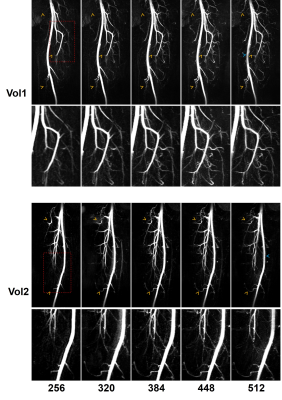 |
Peripheral Fresh Blood Imaging with High Spatial Resolution Using Compressed Sensing
Hao Li1, Martin John Graves1,2, Nadeem Shaida2, Akash Prashar2, David John Lomas1,2, and Andrew Nicholas Priest1,2
1Department of Radiology, University of Cambridge, Cambridge, United Kingdom, 2Department of Radiology, Addenbrooke’s Hospital, Cambridge, United Kingdom
A time-efficient high-resolution 3D fresh-blood imaging technique is proposed. The acquisition matrix size was increased from 256 to 512 in both readout and in-plane phase-encoding dimensions. Imaging efficiency was improved using compressed sensing together with k-space subtraction, so that the acquisition time is not prolonged compared to standard-resolution protocols. To avoid flow-related arterial signal voids, velocity-compensation gradients were used instead of velocity-spoiling gradients, and the spoiler gradients in the slice-encoding direction were increased. By decreasing the pixel size, the overall vessel sharpness and depiction of small vessels were significantly improved, at the cost of reducing the contrast-to-noise ratio.
|
|||
1621.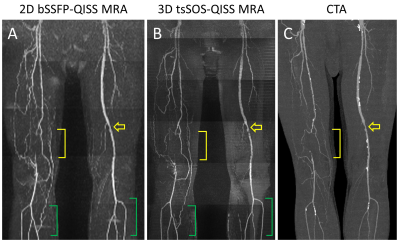 |
Comparison of 2D and 3D Quiescent Interval Slice-Selective Non-Contrast MR Angiography in Patients with Peripheral Artery Disease
Akos Varga-Szemes1, Pascale Aouad2, U. Joseph Schoepf1, Tilman Emrich1, Basel Yacoub1, Thomas M Todoran3, Ioannis Koktzoglou4, and Robert R Edelman4
1Department of Radiology and Radiological Science, Medical University of South Carolina, Charleston, SC, United States, 2Northwestern University, Chicago, IL, United States, 3Department of Medicine, Medical University of South Carolina, Charleston, SC, United States, 4Department of Radiology, Northshore University HealthSystem, Evanston, IL, United States
2D quiescent-interval slice-selective (QISS) MRA is an established technique in peripheral artery disease (PAD), however, its slice thickness is inferior to that used for computed tomography angiography (CTA). The prototype thin-slab stack-of-stars (tsSOS) QISS technique achieves CTA-like slice thickness. In this three-center study, we compared 2D-QISS and tsSOS-QISS MRA for the detection PAD in 23 patients. Overall image quality was not different between tsSOS-QISS and 2D-QISS. AUCs for PAD detection were not statistically different between the techniques (P=0.336). Our results indicate that 3D tsSOS-QISS provides similar accuracy in patients with PAD to a standard commercially available 2D-QISS technique.
|
|||
1622.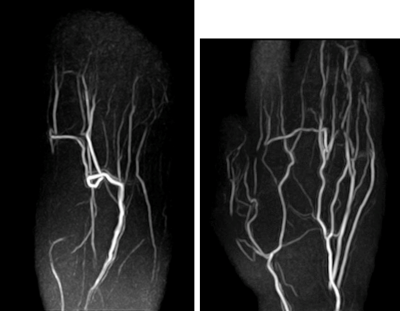 |
Non-contrast high-resolution 4D-peripheral MRA using Retrospective EPI
Yasuhiro Goto1, Michinobu Nagao1, Masami Yoneyama2, Yasutomo Katsumata2, Isao Shiina1, Kazuo Kodaira1, Yutaka Hamatani1, Takumi Ogawa1, Mamoru Takeyama1, Isao Tanaka1, and Shuji Sakai1
1Women's Medical University Hospital, tokyo, Japan, 2Philips Japan, tokyo, Japan
We investigated whether non-contrast, high resolution PPU-triggered 4D-peripheral MRA using Retrospective EPI (REPI). REPI 4D-peripheral MRA with VENC of 10 cm/s showed higher vascular conspicuity compared with the conventional methods.
|
|||
1623.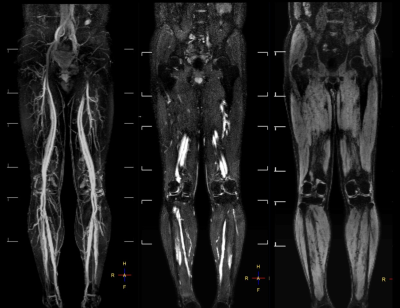 |
Planning-less REACT-MD: Fast and simple run-off exam of the total legs with simultaneous non-contrast MRA and black-blood imaging
Yutaka Hamatani1, Kayoko Abe2, Masami Yoneyama3, Christoph Katemann4, Shuo Zhang4, Yasuhiro Goto1, Michinobu Nagao2, Isao Shiina1, Kazuo Kodaira1, Takumi Ogawa1, Mamoru Takeyama1, Isao Tanaka1, and Shuji Sakai2
1Department of Radioligical Services, Tokyo Women's Medical University Hospital, Tokyo, Japan, 2Department of Diagnostic imaging & Nuclear Medicine, Tokyo Women's Medical University Hospital, Tokyo, Japan, 3Philips Japan, Tokyo, Japan, 4Philips Healthcare, Hamburg, Germany
Magnetic resonance angiography (MRA) is essential to characterize luminal changes and detect abnormalities in peripheral vascular diseases. However, clear depiction of the vascular structures without contrast within a short scan time remains challenging and is often limited by complicated exam and long procedure time. In this study, we employ planning-less REACT-MD (Relaxation-Enhanced Angiography without Contrast and Triggering with Multiple Delays) with simultaneous non-contrast MRA and black-blood imaging for fast and simple run-off exams of the lower extremities without additional scout acquisition and volume planning, aiming to provide multi-contrast images with diagnostic quality and simplified clinical workflow.
|
|||
1624.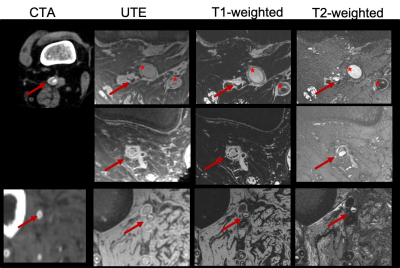 |
Clinical Ultra-High Field Protocol for Visualization and Quantification of Lesion Components in Peripheral Artery Disease
Kavya Sinha1, Christof Karmonik2, Alan B Lumsden1, and Trisha Roy1
1DeBakey Heart & Vascular Center, Houston Methodist Hospital, Houston, TX, United States, 2Translational Imaging Center, Houston Methodist Research Institute, Houston, TX, United States Peripheral arterial disease (PAD) has been estimated to reduce quality of life in approximately 2 million symptomatic Americans, with millions more expected to suffer PAD-associated impairment. Anatomic characteristics of PAD lesions influence clinical outcomes, including the success and durability of endovascular treatments. Current clinical imaging modalities CTA, fluoroscopy and ultrasound do not depict plaque characterization to the extent of MRI. In this abstract we show how clinical ultra-high field protocol can be used for visualization and quantification of lesion components in peripheral artery disease. |
|||
1625.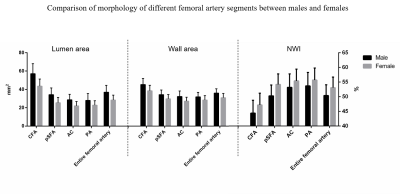 |
Comparison of femoral artery plaque characteristics between men and women in elderly population using magnetic resonance vessel wall imaging
Lichen Zhang1,2, Yongjun Han3, Maobin Guang4, Zhu Zhu4, Jianming Cai5, and Xihai Zhao6
11Medical School of Chinese PLA, Beijing, China., Beijing, China, 2Department of Radiology, the Fifth Medical Center, Chinese PLA General Hospital, Beijing, China., Beijing, China, 3Department of radiology, Aerospace Center Hospital, Beijing, China., Beijing, China, 4Department of Radiology, The Affiliated Hospital of Yangzhou University, Yangzhou University, Yangzhou, China, Yangzhou, China, 5Department of Radiology, the Fifth Medical Center, Chinese PLA General Hospital, Beijing, China., Beijing, China, Beijing, China, 6Center For Biomedical Imaging Research, Department of Biomedical Engineering, School of Medicine, Tsinghua University, Beijing, China, Beijing, China
We sought to investigate the differences of plaque characteristics in different femoral artery segments between males and females using magnetic resonance vessel wall imaging. The 3D-MERGE was acquired from the common femoral artery to the popliteal artery. We compared the differences of femoral artery plaque characteristics between men and women. Men had significantly larger area of lumen and wall, but smaller normalized wall index compared with women. Men have larger vessel size but lower plaque burden then women, more attention is needed to be paid to asymptomatic elderly women.
|
|||
1626. |
Predicting In Vivo Signal Intensity in Contrast Enhanced MRA Based on Blood Concentration of Gadolinium-Based Contrast Agents
Evan Norris1, Guenther Schneider2, Toshimasa Clark1, Miles Kirchin3, Gregory Wilson4, and Jeffrey Maki1,4
1Radiology, University of Colorado, Aurora, CO, United States, 2University Hospital of Saarland, Homburg, Germany, 3Bracco Imaging, Milan, Italy, 4University of Washington, Seattle, WA, United States
Recent insight into the behavior of blood R1 and R2* predicts the precise manner that signal intensity increases, plateaus, and ultimately diminishes with increasing gadolinium-based contrast agent concentration ([GBCA]). This has important implications for optimal GBCA utilization and administration in contrast enhanced MRA (CE-MRA). We validate these theoretical constructs in an in vivo pig model where time resolved CE-MRA and [GBCA] (via mass spectrometry) are acquired simultaneously, demonstrating that the theoretical relationship between [GBCA] and R1, R2* as applied to first pass CE-MRA allows for accurate predictions of CE-MRA signal intensity for any given blood concentration across three different GBCAs.
|
|||
1627. |
Dual-echo 3D-MERGE with Adiabatic Flow Suppression for Large-coverage Carotid Vessel Wall Imaging
Zechen Zhou1, Niranjan Balu2, Holger Eggers3, Peter Börnert3, Thomas S. Hatsukami2, and Chun Yuan2
1Philips Research North America, Cambridge, MA, United States, 2Vascular Imaging Lab, University of Washington, Seattle, WA, United States, 3Philips Research Hamburg, Hamburg, Germany
In this work, a dual-echo 3D-MERGE with adiabatic flow suppression was developed to improve the image quality of large-coverage carotid vessel wall imaging (VWI). The initial experiments on plaque specimen and healthy volunteers have demonstrated its potential for plaque component analysis and feasibility to achieve isotropic 0.8mm VWI with improved fat/flow suppression and additional quantitative fat fraction/field maps by using this ~4min large-coverage scan.
|
|||
1628.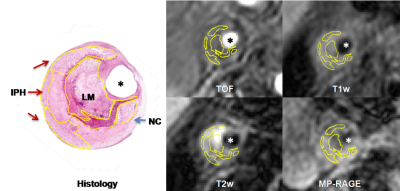 |
Quantitative evaluation of signal intensity threshold for carotid plaque components in cardiovascular MR imaging: Validation by histology
Dongye Li1, Huiyu Qiao2, Yongjun Qiao2, Hualu Han2, Dandan Yang2, Jingli Cao3, Huimin Xu4, Tao Wang4, Jun Shen1, and Xihai Zhao2
1Department of Radiology, Sun Yat-Sen Memorial Hospital, Sun Yat-Sen University, Guangzhou, China, 2Department of Biomedical Engineering, Center for Biomedical Imaging Research, Tsinghua University School of Medicine, Beijing, China, 3China National Clinical Research Center for Neurological Diseases, Beijing Tiantan Hospital, Capital Medical University, Beijing, China, 4Peking University Third Hospital, Beijing, China
It is important to accurately identify carotid necrotic core (NC), intraplaque hemorrhage (IPH) due to its strong association with ischemic stroke. Multi-contrast cardiovascular magnetic resonance (CMR) vessel wall imaging has become an effective non-invasive technique to assess carotid plaque components. The aim of this study sought to confirm criteria of signal intensity threshold of all plaque components by comparing multiple tissue references validated by histology. This study afforded a standard of the signal intensity threshold ratio of carotid plaque components compared to reference tissues on multi-contrast cardiovascular MR imaging, and provides the basis for accurate identification of crucial plaque components.
|
|||
1629.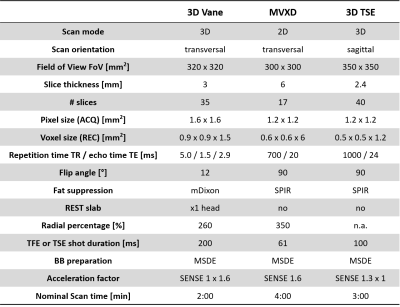 |
Free-breathing T1-weighted black-blood vessel wall MRI based on radial imaging with motion sensitized driven equilibrium (MSDE) preparation
Takashi Namiki1, Hiroshi Hamano1, Naoki Udo2, Inka Ristow3, Felicia-Marie von Düring3, Alexander Lenz3, Shuo Zhang4, and Masami Yoneyama1
1Philips Japan, Tokyo, Japan, 2Department of Radiological technology , Yuuai Medical Center, Okinawa, Japan, 3Department of Diagnostic and Interventional Radiology and Nuclear Medicine, University Hospital Hamburg-Eppendorf, Hamburg, Germany, 4Philips, Hamburg, Germany
Black-blood MRI is essential to characterize vessel wall in vivo and to identify vascular abnormalities. However, clear depiction of the wall structures in the thoracoabdominal region remains challenging and often suffers from pulsation or breathing artifacts. In this study, we employ motion sensitized driven equilibrium (MSDE) preparation technique and combine with radial-based 3D gradient- and 2D spin-echo imaging pulse sequences. Initial results in healthy volunteer and patients are reported in comparison to the conventional bright-blood and Cartesian techniques, which have shown promise in detection of vessel wall lesions before or after injection of contrast agent.
|
|||
1630.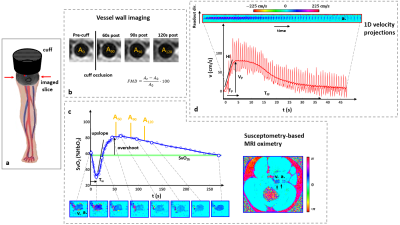 |
Quantitative MRI to compare vascular health in nonsmokers, smokers, and vapers.
Alessandra Caporale1, Michael Langham1, and Felix W Wehrli1
1Radiology, Laboratory for Structural, Physiologic and Functional Imaging, Perelman School of Medicine, University of Pennsylvania, Philadelphia, PA, United States
To investigate the effects of chronic exposure to cigarette smoke or electronic cigarette aerosol on the vascular endothelium, various MRI parameters were examined in an ongoing study involving healthy young people (mean age<30y). Peripheral, cerebrovascular reactivity, and central aortic stiffness were evaluated comparing smokers (N=11) and vapers (N=15) to their nonsmoking-peers (N=31). There were no significant differences between groups, but hyperemic blood flow acceleration trended lower in smokers/vapers while arterial stiffness trended higher in smokers, relative to nonsmokers. The findings may suggest that exposure in these young subjects was not be sufficient to cause measurable adverse effects on the endothelium.
|
The International Society for Magnetic Resonance in Medicine is accredited by the Accreditation Council for Continuing Medical Education to provide continuing medical education for physicians.